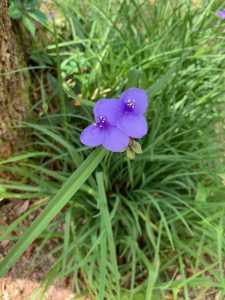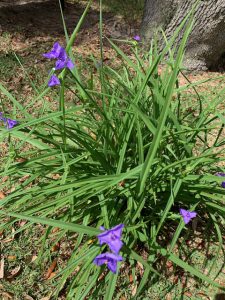
The brilliant purple, edible spiderwort flowers are only around for a day! Photo credit: Mary Anne Tomlinson
The spiderwort is a pretty little plant that most people have encountered in their yards or on roadsides. In cattle or hay pastures, it is considered a weed because cows won’t eat it, and its high moisture content can ruin hay harvests. In a home landscape, though, it can be a nice addition to the yard. I know many homeowners who refuse to let them be mowed down with the lawn simply because of their brilliant color. The native spiderwort (genus Tradescantia) is a perennial flower that grows in clusters, often in moist soils. It is a member of the dayflower family, which means each flower is only open for a single day. The plant, a favorite of bumblebees, can be identified quickly by its triad of violet petals and bright green, strap-like leaves.

Spiderworts bloom in spring and grow in clumps of bright green, strappy leaves. Photo credit: Mary Anne Tomlinson
Known by common names as varied as “Bluejacket,” “Snotweed,” and “Cow Slobber” (due to the mucilaginous—mucus-like–consistency of its sap), the plant is widespread throughout the eastern and central United States. An interesting aspect of this sap is that it can be used as a salve for insect bites, similarly to aloe. Even more useful for those interested in native edible plants is that the flowers, stems, and leaves can be eaten raw in a salad or cooked and used as a culinary herb. The flowers can be candied with sugar as a dessert or used atop cakes.
Interestingly, the spiderwort can also indicate the presence of radiation. The bluish hairs on spiderwort flower stamens will turn pink in the presence of low levels of radiation, often more reliably than mechanical dosimeters.
- Hurricane Season 2025 - July 7, 2025
- The Striped Burrfish - April 11, 2025
- The Value of Biodiversity - March 28, 2025
